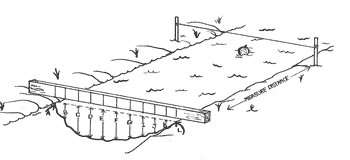Planning Your Own Hydro System
Bookmark this page (Ctrl+D)
![]() View/Print PDF Version
View/Print PDF Version
Guide Navigation
Measuring Flow
More About Measuring Flow
Method 2: Measuring with a Float
The Float method is useful for large streams if you can locate a section about 10 feet long where the stream is fairly consistent in width and depth.

STEP 1: Measure the average depth of the stream. Select a board able to span the width of the stream and mark it at one-foot intervals. Lay the board across the stream, and measure the stream depth at each one-foot interval. To compute the average depth, add all of your measurements together and divide by the number of measurements you made.
STEP 2: Compute the area of the cross section you just measured. Multiply the average depth you just computed by the width of the stream. For example, a 6-foot wide stream with an average depth of 1.5 feet would yield a cross section area of 9 square feet.
STEP 3: Measure the Speed. A good way to measure speed is to mark off about a 10-foot length of the stream that includes the point where you measured the cross section. Remember, you only want to know the speed of the water where you measured the cross section, so the shorter the length of stream you measure, the better.
Using a weighted float that can be clearly seen (an orange works well), place it in the stream well upstream of your measurement area, and then use a stopwatch to time how long it takes to cover the length of your measurement section (e.g. 10 feet). The stream speed probably varies across its width, so record the times for various locations and average them.
With these time and distance measurements, you can now compute the water speed.
For example, let’s assume it took 5 seconds for your float to travel 10 feet:
- 10 feet / 5 seconds = 2 feet per second, or
- 2 feet per second x 60 = 120 feet per minute
You can then compute FLOW by multiplying the feet traveled by the cross section area. Using our cross section area and speed examples:
- 120 feet per minute x 9 square feet = 1,080 cubic feet per minute (cfm) FLOW
STEP 4: Correct for Friction. Because the stream bed creates friction against the moving water, the bottom of the stream tends to move a little slower than the top. This means actual flow is a little less than what we computed. By multiplying our result by 0.83, we get a closer approximation of actual flow:
- 1,080 CFM x 0.83 = 896.4 cfm (cubic feet per minute), or
- 896.4 CFM / 60 = 14.94 cfs (cubic feet per second)